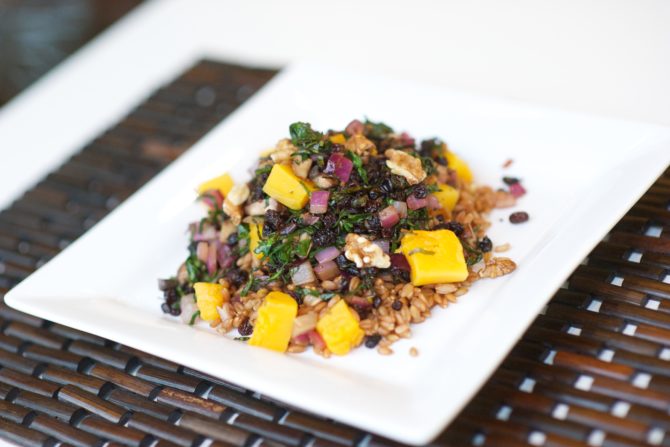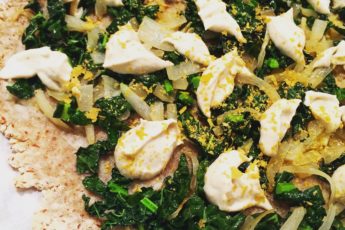If your definition of eating whole grains is eating a whole-wheat bagel then think again. Eating whole grains actually means eating the WHOLE grain in its entirety and not just the flour.
Your body needs grains, as they are an essential source of complex carbohydrates and fiber. Whole grains are slow burning, which means they provide your body with long lasting energy.
There is a world of grains beyond whole wheat.
Here are some of the top grains to include in your diet!
Oats
What it is:
- There are four common types of oats listed here and they are in order of nutritional content: fiber oat groats (whole oat), steel cut oats (cracked oats), rolled oats and quick oats.
How to use it / store it:
- For all types, it is best to add the oats to cold water and then cook at a simmer for 10-30 minutes depending on the variety.
- For raw porridge, soak rolled oats overnight for a ready to go breakfast in the morning.
- Store oatmeal in an airtight container in a cool, dry and dark place where they will keep for approximately two months.
Health Benefits:
- Oats, oat bran, and oatmeal contain fiber, which help to lower cholesterol levels. Oats are also beneficial for stabilizing blood sugar levels and contain antioxidants, which reduce the risk of cardiovascular disease.
Barley
What it is:
- Barley is a versatile cereal grain with a rich nutlike flavor and chewy, pasta-like consistency.
How to use it / store it:
- After rinsing, add one part Barley to three and a half parts boiling water or broth. After the liquid has returned to a boil, turn down the heat, cover and simmer.
- Store Barley in a tightly covered glass container in a cool, dry place. Barley can also be stored in the refrigerator.
Health Benefits:
- Barley is an incredible source of soluble fiber and B vitamins. Both are essential for lowering cholesterol and protecting against heart disease.
Kamut
What it is:
- It is a long grain with a brown cover –similar looking to brown basmati rice. It has a sort of nutty flavor and is closely related to wheat.
How to use / store it:
- Soak 1-cup Kamut overnight. Then add 3 cups water and bring it to a boil. Add a pinch of salt (if needed). Bring the heat to low and simmer for 40-45 minutes or until tender.
Health Benefits:
- 20 to 40 percent more protein than wheat and is richer in several vitamins and minerals such as calcium and selenium.
- Unlike some grains, Kamut has a low oxidation level and retains most of its nutritive value even after grinding and processing.
Spelt
What it is:
- A wonderfully nutritious and ancient grain also known as Farro with a deep nutlike flavor, it is a cousin to wheat
How to use / store it:
- Store spelt grains in an airtight container in a cool, dry and dark place. Spelt flour should be kept in the refrigerator to best preserve its nutritional value.
- After rinsing, soak spelt in water for eight hours or overnight. Drain, rinse and then add three parts water to each one part spelt berries. Bring to a boil, then turn down the heat and simmer for about one hour.
Health Benefits:
- In addition to being an amazing source of fiber and niacin, spelt is also easier to digest than wheat.
Brown Rice
What it is:
- The process that produces brown rice removes only the outermost layer, the hull, of the rice kernel and is the least damaging to its nutritional value.
- This is unlike white rice, which is polished and so most of its nutrients are destroyed in which case it is required to be enriched with vitamins.
How to use / store it:
- Since brown rice still features an oil-rich germ, it is more susceptible to becoming rancid than white rice and therefore should be stored in the refrigerator. Stored in an airtight container, brown rice will keep fresh for about six months.
- After rinsing brown rice, add one-part rice to two parts boiling water or broth. After the liquid has returned to a boil, turn down the heat, cover and simmer for about 45 minutes.
Health Benefits:
- Brown rice is gluten free, light and an incredible source of long lasting carbohydrates for energy. It is also high in fiber and contains several vitamins and minerals.
- Brown rice also contains protein.
Then there is a category of grains called pseudo grains. This includes Quinoa, Buckwheat, Teff and Amaranth and Wild Rice. They are more of a seed than they are a grain, but often get lumped into the grain category. They are all gluten free, high in fiber and protein. They also contain essential vitamins and minerals and are sources of slow burning energy.
Warm Farro Salad
- Yield: 6 Servings
- Prep: 15 mins
- Cook: 60 mins
- Ready In: 1 hr 15 mins
If your definition of eating whole grains is eating a whole-wheat bagel then think again. Eating whole grains actually means eating …
Ingredients
Instructions
1. Preheat oven to 350F. Rinse and place farro into a pot with vegetable stock and 1 cup of water. Bring to a boil, reduce heat and simmer for 45 minutes to 1 hour.
2. Set aside farro.
3. Place cubed butternut squash on a baking tray with 1 tablespoons of olive oil and place in the oven for 30 minutes.
4. In a saucepan, heat 1 tablespoon olive oil with garlic over medium heat and add onions, mushrooms and currents and sauté until softened.
5. Add spinach or chard, sea salt, dry herbs and balsamic vinegar. Let sit to let the flavours combine for a few minutes.
6. Place cooked farro into a large bowl, add olive oil, and butternut squash and onion, mushroom, spinach mixtures and stir everything in.
7. Add walnuts and crumbled goat cheese.


